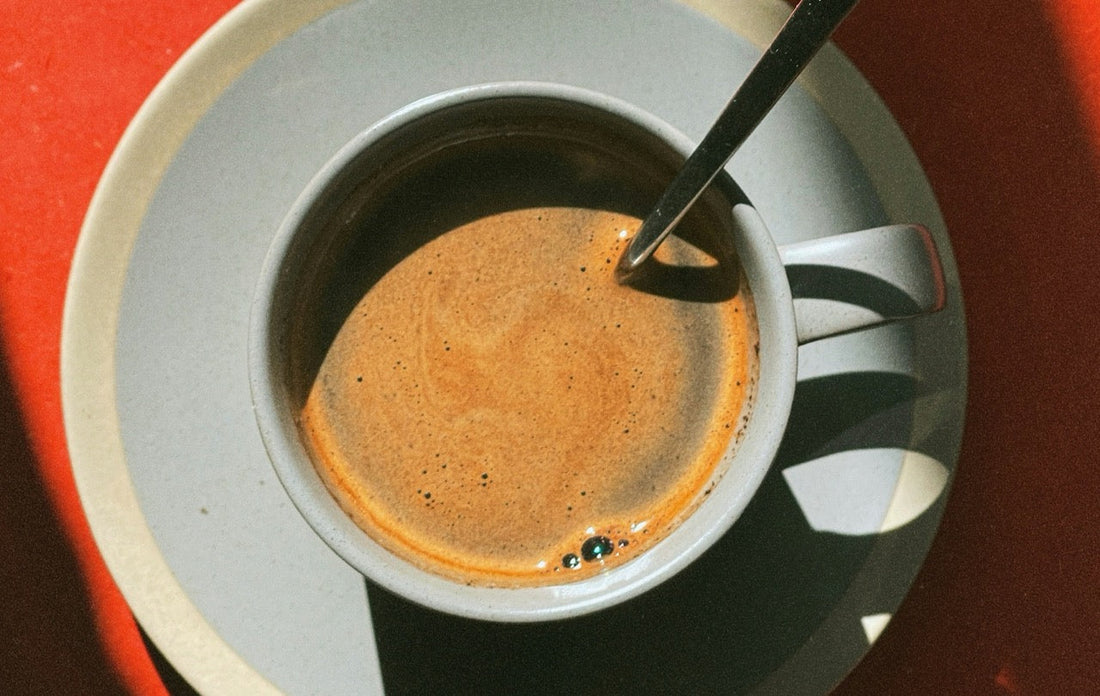
Table of Contents
- Why this matters now
- Is coffee high in histamine—or just misunderstood?
- Beyond histamine: the other coffee compounds that can bother you
- What our testing showed (Starbucks Pike Place, 8 oz, 5-minute exposure)
- Real-world test: Julian’s coffee journey (full transparency)
- Why this matters in real life: taste, energy, and comfort
- How to try this at home: a simple protocol
- Decaf, cold brew, “low-acid” vs filtration: quick comparison
- Making coffee effectively “low histamine” (and why consistency matters)
- Building a lower-histamine day without giving up what you enjoy
- A real customer story
- Transparency, patents, and scientific rigor
- Final thoughts & where to learn more
- FAQ: quick answers to common questions
1. Why this matters now
If you love coffee but it doesn’t always love you back—triggering symptoms such as headaches, sinus pressure, gut discomfort, or that “wired-but-tired” edge—you’re not imagining it. Over the past year, we kept hearing from customers who were dropping ALKAA sachets into their coffee, not just wine. That wasn’t our original use case, but when people start reporting relief, I pay attention.
So we ran controlled tests. What we found surprised even me: you can make coffee measurably “cleaner”—not by changing the roast or switching to decaf, but by reducing specific compounds that tend to irritate sensitive folks. This article walks through what’s actually in coffee (beyond caffeine), what we measured, and what that means for enjoying your daily ritual with fewer side effects.
Note: This isn’t medical advice. I’m sharing our lab results, firsthand observations, and real customer experiences so you can make informed choices.
2. Is coffee high in histamine—or just misunderstood?

If you’ve ever wondered whether your favorite morning brew adds to your histamine load, you’re not alone. “Coffee and histamine” has become a hot topic—and for good reason.
Let’s start simple: yes, coffee contains histamine, but only in small amounts. It’s nowhere near the levels in classic histamine heavy-hitters like aged cheeses or fermented foods. Still, if you’re histamine-sensitive, even tiny traces can matter—especially when they stack with other triggers over the day.
So would I call coffee a high-histamine food? Not generally. But two people can drink the same cup and have very different reactions. That’s because what bothers you may not be histamine alone; other compounds in coffee can amplify the reaction. Later in this article, I’ll share data showing how a short filtration step can make a brewed cup behave more like low histamine coffee for sensitive drinkers—without cutting caffeine or flavor.
Coffee naturally contains trace amounts of biogenic amines—a chemical group that includes histamine, tyramine, and others produced during fermentation or roasting. While most people metabolize these compounds easily, those with histamine intolerance or sluggish DAO enzyme activity may notice reactions after drinking coffee.
- Does coffee have histamine? Yes—usually small amounts.
- Is coffee high in histamine? Not compared to aged/fermented foods, though sensitive individuals can still react.
- Why the mixed experiences? Because histamine is only part of the picture; other compounds can push things over the edge.
3. Beyond histamine: the other coffee compounds that can bother you
Here’s the piece most people miss: histamine isn’t the only trigger. Coffee also contains:
- Acetaldehyde. A reactive compound that, in many beverages, correlates with the “flushed and foggy” feeling some people report. Reducing it seems to track with calmer, clearer post-coffee energy for a subset of drinkers.
- Coffee oils (N-alkanoyl-5-hydroxytryptamide). Certain oils can be rough on sensitive stomachs; trimming them can make coffee feel gentler.
- Chlorogenic acids. These contribute to mouthfeel and antioxidant profile; most people want to keep them.
- Caffeine. Not the enemy—but when other irritants are reduced, caffeine often feels smoother (same clarity, fewer jitters).
This is why broad questions like “coffee and histamine intolerance” don’t always have a tidy yes/no answer. For some, histamine is the main lever. For others, acetaldehyde or specific oils are the real culprits. For many, it’s a combo effect.
In sensitive individuals, histamine can contribute to an exaggerated immune response—sometimes linked to mast cell activation syndrome (MCAS). When mast cells release too much histamine, caffeine or other compounds may amplify the effect, triggering symptoms like flushing, anxiety, or headaches even from a small cup.
4. What our testing showed (Starbucks Pike Place, 8 oz, 5-minute exposure)
After customers began reporting good results, we tested Starbucks Pike Place brewed coffee (8 oz serving) using a 5-minute, tea-bag–style movement of a standard ALKAA sachet. Here’s what we measured:
| Compound | % Change | What it means for you |
|---|---|---|
| Histamines | –100.00% | Complete removal. For histamine-sensitive folks, that’s a big deal. |
| Acetaldehyde | –16.67% | Meaningful reduction in a reactive by-product linked to that “off” feeling. |
| Coffee oils (N-alkanoyl-5-hydroxytryptamide) | –12.50% | Moderate drop; often reported as easier on the stomach. |
| Caffeine | –2.05% | Virtually preserved—keeps the caffeine “kick.” |
| Chlorogenic acid | –1.09% | Flavor & antioxidant profile preserved. |
| Tannins | Non-detectable | Potentially less bitterness. |
Data notes: This is one coffee, one serving size, one exposure time. Roasts, grind size, brew method, and contact time will vary outcomes. We’re continuing to test and will share more as we go.


Real-world test: Julian’s coffee journey
 After we ran those numbers, my son Julian decided to see how it felt in real life. (Transparency matters: yes, he’s my son. This wasn’t staged or sponsored—he had actually quit coffee months earlier because it hurt his sleep and felt too acidic. He wanted a way back.)
After we ran those numbers, my son Julian decided to see how it felt in real life. (Transparency matters: yes, he’s my son. This wasn’t staged or sponsored—he had actually quit coffee months earlier because it hurt his sleep and felt too acidic. He wanted a way back.)
One day, he brewed a full Chemex from @valkyriecoffeeroasters and dropped in an ALKAA sachet for five minutes, swirling intermittently.
Here's what he had to say:
“I slept great last night. No anxious crash, no acid in my stomach… I still feel chatty, so the caffeine’s definitely there.”
“I don’t feel anxious. My stomach feels good. I really enjoy the taste of black coffee again.”
Watch Julian's story on Instagram: Part 1 | Part 2 | Part 3
His experience mirrors the lab results: same flavor and energy, fewer side effects. Stories like Julian’s keep us testing because they show what the numbers mean for real people who want to enjoy coffee again.
6. Why this matters in real life: taste, energy, and comfort
The goal isn’t to sterilize coffee. The goal is to keep what you love—aroma, flavor, caffeine—while reducing what doesn’t love you back.
- Comfort gains. Removing histamine and trimming acetaldehyde and certain oils often makes coffee feel smoother—less sinus pressure, calmer stomach, fewer “edgy” jitters.
- Flavor fidelity. Because caffeine and chlorogenic acids are largely preserved, your cup still tastes and performs like coffee—not a watered-down compromise.
- Load management. Many people stack histamine through the day (morning coffee, lunch meats, evening wine). Starting with a cup that behaves more like low histamine coffee helps keep the overall load in check.
Analogy: Think of ALKAA like removing the static from your morning soundtrack—same song, cleaner signal.
7. How to try this at home: a simple protocol
- Brew as usual. Drip, pour-over, French press—whatever you like. Aim for 8–12 oz for consistency.
- Add one ALKAA sachet to the finished coffee.
- Swirl intermittently for 5 minutes. Tea-bag style—gentle, not aggressive.
- Taste. Notice flavor and mouthfeel; also take note of how you feel in the first hour and later (anxiety, stomach, sinuses, sleep).
- Adjust time if needed. If your brew is especially bold or your mug is larger, try 6–8 minutes and re-evaluate.
What to expect: In our tests, caffeine and flavor markers were essentially preserved, while histamine fell to undetectable and other irritants dropped modestly. Individual results vary with beans, roast, grind, and brew technique.
8. Decaf, cold brew, “low-acid” vs filtration: quick comparison
Even decaffeinated coffee can contain histamine and acetaldehyde—compounds unrelated to caffeine itself. So while decaf may reduce stimulation, it doesn’t necessarily prevent histamine-related discomfort.
| Approach | What it optimizes | What it doesn’t | Who it helps |
|---|---|---|---|
| Decaf | Major caffeine reduction | Doesn’t target histamine/ acetaldehyde/oils |
Those who react mainly to caffeine |
| Cold brew | Perceived acidity; smoother mouthfeel | Histamine may still be present; acetaldehyde/oils vary | Those with acid sensitivity more than histamine sensitivity |
| “Low-acid” roasts | Lower acid perception | No guarantee on histamine/ acetaldehyde/oils |
Those who equate “acid taste” with discomfort |
| ALKAA (5-min exposure) | Targets histamine (→ undetectable in our test), trims acetaldehyde & oils | Doesn’t “zero out” caffeine or chlorogenic acids | Those who want coffee benefits with fewer usual offenders |
Why this matters: broad questions like “coffee histamine intolerance” blur together different triggers. If histamine is your issue, decaf alone won’t fix it. If oils bother your stomach, cold brew may help—but not always. A multi-compound approach is the point.
9. Making coffee effectively “low histamine” (and why consistency matters)
In our Pike Place test (8 oz, 5 minutes), histamines were undetectable after treatment—functionally low histamine for that cup. Results vary with bean origin, roast, grind, time, and brewing style, so the best way to dial it in is to standardize your routine for a week and see how you feel.
- Use a timer. Five minutes is a good starting point; heavier brews may benefit from six or seven.
- Keep notes. Track sleep, mood, and gut comfort for a few days. Patterns emerge fast.
- Don’t chase zero everything. Preserving caffeine and chlorogenic acids is part of why this works for daily life.
Histamine and other biogenic amine levels vary by bean origin and roast. Green coffee beans, for instance, tend to have lower biogenic amine formation before roasting. Once roasted, heat and oxidation can slightly increase these compounds—another reason filtration at the cup stage makes sense.
10. Building a lower-histamine day without giving up what you enjoy
If you’re managing sensitivity, two ideas go a long way:
- Start the day with a lower load. If your morning coffee behaves like low histamine, you’re not “spending” your tolerance before lunch.
- Watch stacking. A sandwich with aged meats and cheese plus an evening glass of wine can tip you over the edge—even if the coffee felt fine. Small, smart adjustments across the day can add up.
For evening tweaks and a deeper dive on alcoholic beverages, see our guide to low histamine alcohol—a practical way to keep the ritual while minimizing rough mornings.
11. A real customer story
“I use ALKAA in coffee… I now get to enjoy a cup of Joe as it’s meant to be enjoyed—and for that I am grateful.” — A.B., Verified Customer (Dec 2023)
I appreciate stories like this because they teach us. In this case, customers started using ALKAA in coffee before we tested it. We followed their lead and let the data confirm—then refine—the experience.
12. Transparency, patents, and scientific rigor
Patented approach
ALKAA’s filtration technology is patented. Our aim is simple: reduce troublesome compounds while preserving what makes coffee enjoyable.
Independent lab testing
We generate data under controlled conditions and keep expanding the scope: coffee, tea, wines, and beyond.
Editorial policy
We publish measurements first. Claims follow data—not the other way around.
Expert perspective
For a broader, science-forward overview of why we target specific compounds and how we think about risk reduction, see our Toxin Report (7 Toxins in Alcoholic Beverages and Their Health Effects) authored by Microbiologist Sheik Saba Naz.
Where we’re testing next
- Glyphosate in wine
- Sweeteners
- …and more
13. Final thoughts & where to learn more
We started ALKAA to help people enjoy what they love with fewer noxious by-products. Alcohol was our first frontier, and that research continues. But customer curiosity nudged us to test coffee—and the early results are promising. This isn’t a cure-all or a medical device. It’s a patented, data-driven way to make an everyday ritual feel better, with fewer tradeoffs.
If you’re exploring ways to reduce everyday irritants in what you drink, you might also appreciate our guide to low-histamine wines and the Toxin Report by Microbiologist Sheik Saba Naz. And if you test this at home with a 5-minute exposure, let us know what you notice—flavor, comfort, sleep, and anything in between. Your stories help us decide what to test next.
FAQ: quick answers to common questions
Does coffee have histamine?
Yes—coffee naturally contains small amounts of histamine. In our testing, a 5-minute sachet exposure dropped it to undetectable in a brewed cup.
Is coffee high in histamine?
Not compared with aged or fermented foods. But if you’re sensitive, even trace amounts can matter—especially when combined with other triggers.
Is coffee low histamine after filtration?
In our 8-oz Pike Place test, histamine was undetectable after 5 minutes. Beans and methods vary; consistency helps.
Is histamine the only reason coffee makes me feel off?
No. Our data and customer feedback point to acetaldehyde and certain coffee oils as additional contributors. Reducing multiple compounds—not just histamine—seems to matter.
Does ALKAA reduce caffeine?
Only slightly in our data (~2%), which is why the cup still “works” like coffee.
Will this change the taste?
Chlorogenic acids (important to flavor/antioxidant profile) dropped by ~1% in our test. Most tasters describe a familiar cup with a smoother feel.
Can I use this with tea?
Many customers do. Compounds differ by tea type, but the same 5-minute exposure is a sensible starting point. We’ll publish more tea data as testing expands.
Data & Methods (brief)
- Coffee tested: Starbucks Pike Place, brewed cup, 8 oz serving
- Exposure: ALKAA sachet submerged with gentle movement for 5 minutes (tea-bag style)
- Highlights: Histamines –100%; Acetaldehyde –16.67%; Coffee oils –12.50%; Caffeine –2.05%; Chlorogenic acid –1.09%; Tannins non-detectable
- Disclaimer: Lab conditions controlled; results vary with roast, grind, brew method, and contact time.
Photo by Lobacheva Ina on Unsplash
Photo by Nathan Dumlao on Unsplash


